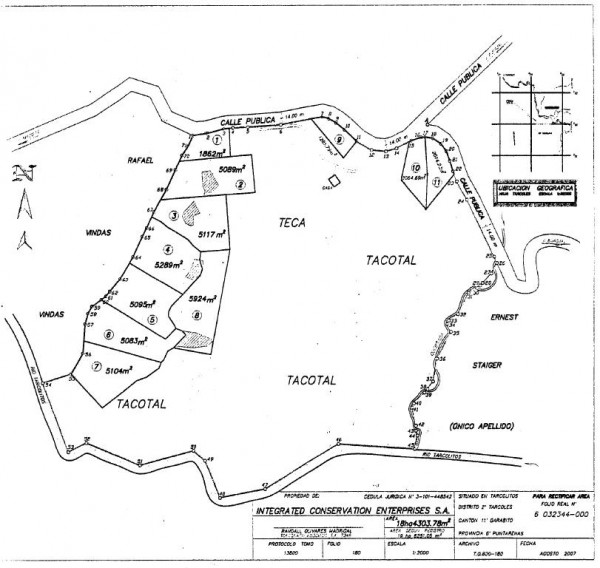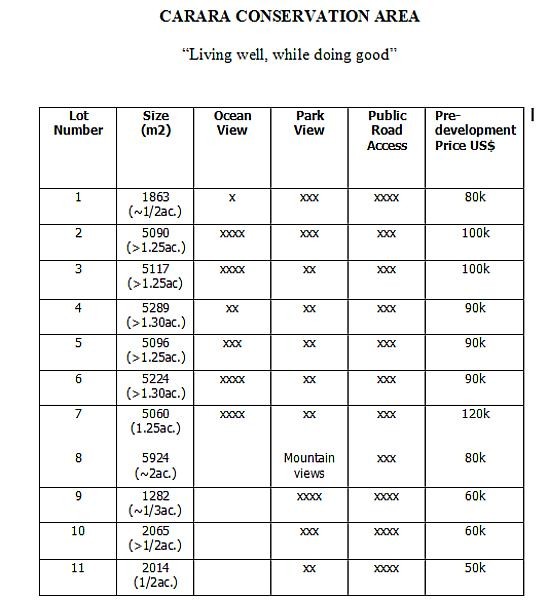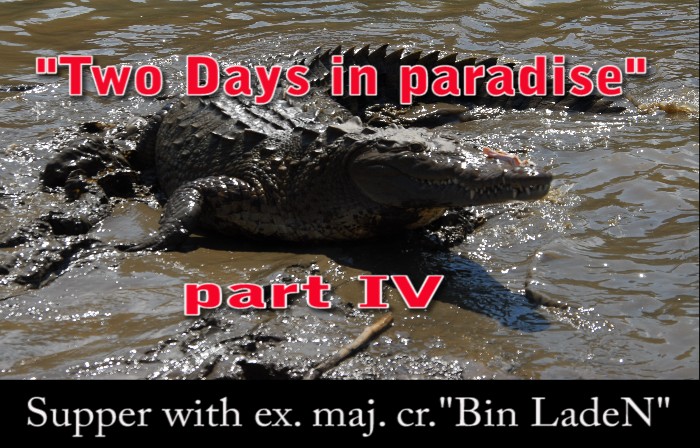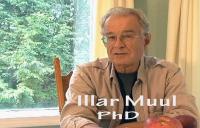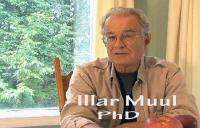COSTA RICA: RAINFOREST REAL ESTATE
Illar Muul, PhD, Founder and President
Integrated Conservation Research (ICR)
Costa Rica offers a wide variety of opportunities to visit and live in an ideal natural and cultural environment. If your interests include nature or conservation of tropical rainforests, we can offer you a unique opportunity for “Living well, while doing good.”
“Living Well…”
Integrated Conservation Research (ICR) has developed a strategy that is in some ways counterintuitive, but has great potential to serve both the needs of people and of wildlife and their habitats. In our Carara Conservation Community (CCC), in Costa Rica, ICR has designated home sites on abandoned agricultural land (soil is not suitable for “crops”). Located mainly on a ridge with ocean and pastoral views, at CCC you will enjoy a moderate climate (at 500m or 1600ft elevation), yet you are within a 30 minute drive to beaches, health care facilities, world class restaurants, shopping, banks, entertainment, etc. You will be amazed to see such a clear night sky since you are away from the lights and noise of “development.”
The ICR owned Carara Conservation Area (CCA) has an extensive system of interpretive trails that lead you to closed canopy, original forest, to Tarcolitos River (the southern boundary), and through regenerating forest on former farmland. The river is very scenic, with large pools suitable for swimming, contrasted by rapids among rock formations. Ample picnic sites exist along the river trails, including near small waterfalls in streams feeding into the river.
Abandoned farming has left behind numerous fruit trees that attract an abundance of wildlife to the property. Within a 10 minute walk you can reach one of the world’s most beautiful botanical gardens: Pura Vida Botanical Gardens and Waterfalls. There you will also find a small restaurant, when you do not wish to cook.
“…While Doing Good”
By becoming part of CCC, you will be helping to validate ICR’s strategy for reforestation. Though about 25% of Costa Rica’s land is protected in National Parks, the rest is vulnerable to various forms of development. ICR’s strategy is to create a model for ecologically sustainable development through reforestation (with high biodiversity), but with a bias toward species of economic value to humans and as a source of food and shelter for wildlife. The strategy is designed to compete against various forms of “agri-business” which is usually based on cultivation of single species (monocultures) (see www.incores.org; click on “agroecosystems”).
Your purchase of a home site helps us develop such a model on CCA and neighboring properties. Our immediate objective is to create a “biodiversity corridor” between our small original forest and nearby Carara National Park, the boundary of which can be seen on the northern horizon from most home sites. Such a model can be applied to reconnect most of Costa Rica’s Parks with “biodiversity corridors” comprised of agroecosystems that benefit both humans and wildlife.
“Value Added” From Rainforests
Nature is the main attraction for most people who visit Costa Rica, and to those who ultimately choose to own a home there. My colleague Professor E.O. Wilson analyzed this attraction to nature in his book, “Biophilia.” Proximity to nature also enhances real restate value. For example, in Washington D.C., homes bordering Rock Creek Park are substantially more expensive than equivalent homes on the same street, but more distant. Even in New York City, homes with a view of Central Park are much more expensive that those in the same building that have no “view.”
My former home town, Sharon, Massachusetts, was recently ranked as “most desirable” in the U.S.A,, largely because of preserved natural landscape, including forested land purchased long ago by futuristic people who could afford to do that.
Home sites on our Costa Rica properties have a great variety of natural attractions, permanently protected by easements. Rainforest restoration models are the main objectives of ICR’s conservation programs under development. You can help make it happen.
About ICR
ICR is a 501-c-3 non-profit organization (EIN #51-0308422 for IRS validation). It was founded in 1988 with initial start-up help from the Smithsonian’s Museum of Natural History, the U.S. Man and the Biosphere Program (US MAB), National Geographic Society, and UNESCO (MAB). The initial project sites in Malaysia (Borneo) and China (Yunnan) are now designated as UNESCO’s World Heritage Sites.
As examples of ecologically and economically sustainable development, these projects attracted attention throughout the world. ICR was asked to develop similar projects in Peru (2), Costa Rica, Guyana, Ghana, and Sri Lanka (interrupted by the war) and at additional sites in Malaysia (4) and China. Local people trained by ICR now install “canopy walkways” independently.
All these projects opened up access to the canopies of tropical rainforests for research and tourism using suspension bridges and platforms in the trees. The technique was “invented” by Dr. Illar Muul, Founder and President of ICR in 1969 for research. It serves rainforest tourism in a manner similar to what Jacque Coustou’s scuba gear does for coral reef exploration.
But, ICR’s conservation strategy is designed to go far beyond tourism. Our new Costa Rica project is an important part of developing demonstration models, to serve other aspects of our strategy. You can help.
Contact Information
For more information about this opportunity and how to contact us, see www.incores.org, click on “Tropical Rainforest Residences” or “Eco-acres”, or contact us directly ; or call 301 371 8988, and see a video: “Two days in Paradise” at Estonian World Review, www.eesti.ca. We are currently offering for a limited time (ICR’s 25th Anniversary) any one of lots #9, #10, or #11 at ½ price. ICR’s list of international “Accomplishments” is available by request. Thank you for your interest and please pass this information on to other like-minded people.
LOT DESCRIPTIONS
Carara Conservation Community (CCC) Costa Rica
Located near Carara National Park (CNP)
Lot #1: Located on the public road to Bijagual, this lot is ideal for a small restaurant or “Bed and Break-fast.” Wonderful views of hillside pastures and lush valley below. Ample parking on a lower terrace.
Lot #2: Wonderful views in every direction, including the Pacific Ocean and CNP on the horizon in the opposite direction. Has lower terrace for gardens or tennis court.
Lot #3: One of the best views of the ocean, mountains, pastures and valleys. Three terraces possible, ideal for privacy and multiple uses.
Lot #4: Located on an extended ridge, at two levels, this lot would be ideal for a duplex, yet retain privacy. Beautiful views in every direction.
Lot #5: We call this “Macaw Hill” since these striking birds can be seen every day as they fly through the river valley below. Ocean view and valley views in all directions, yet there is ample space for gardens on gentler slopes below. A large, lower terrace is ideal for tennis court, pool, parking, or helicopter landing site.
Lot #6: We have named this “Guava Hill.” Numerous guava trees remain from this former orchard. Yet, below is one of the few Guanacasta trees (the National Tree of Costa Rica). Many other native trees are regenerating on this property, including numerous Arbol Mayo (May Tree), with spectacular yellow blossoms in May. Also, ocean and valley views.
Lot #7: This is a special property for nature lovers. Apart from the most spectacular of the ocean views, this area is mostly preserved, original forest. In the tall trees that form a closed canopy, monkeys and macaws are frequent visitors. A scenic trail leads down to Tarcolitos River, part of the future Bio-Park.
Lot #8: This property is ideal for gardeners, with plenty of “flat” land and gentle slopes. Yet, if you wish, you can locate your home on existing steeper hillside for a “commanding view” of the valley and original forest below, along Tarcolitos River. An existing trail through the future interpretive “Bio-Park” leads you to the river at a spot with several areas suitable for swimming and picnics.
Lot #9, #10, #11: They are similar to Lot 1.
General
The Carara Conservation Area (CCA) has many existing trails which can be used for nature walks, with many attractive sites for picnics and planned “nature interpretation” venues. Most of CCA is former agricultural land which in now being reclaimed by Integrated Conservation Research (ICR) through reforestation.
Vaado Sarapuu video EWR
COSTA RICA: RAINFOREST REAL ESTATE VIDEO
Illar Muul PhD | 19 Feb 2014 | EWR
Illar Muul PhD
TRENDING






